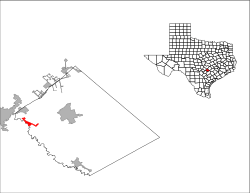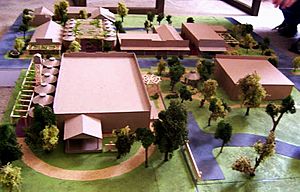Martindale, Texas facts for kids
Quick facts for kids
Martindale, Texas
|
|
|---|---|

Downtown Martindale.
|
|

Location of Martindale, Texas
|
|
 |
|
| Country | United States |
| State | Texas |
| County | Caldwell |
| Incorporated | 1982 |
| Area | |
| • Total | 2.09 sq mi (5.42 km2) |
| • Land | 2.06 sq mi (5.34 km2) |
| • Water | 0.03 sq mi (0.07 km2) |
| Elevation | 528 ft (161 m) |
| Population
(2020)
|
|
| • Total | 1,253 |
| • Density | 596.70/sq mi (230.35/km2) |
| Time zone | UTC-6 (Central (CST)) |
| • Summer (DST) | UTC-5 (CDT) |
| ZIP code |
78655
|
| Area code(s) | 512 |
| FIPS code | 48-46848 |
| GNIS feature ID | 2411044 |
| Website | http://www.martindale.texas.gov/ |
Martindale is a small city located in Caldwell County, Texas, in the United States. It's part of the larger Austin area. In 2020, about 1,253 people lived there.
Martindale is known for its old-fashioned charm, which has made it a popular spot for filming movies and TV shows. Many famous productions have been filmed here, including A Perfect World with Clint Eastwood, The Newton Boys with Matthew McConaughey, and the 2003 remake of The Texas Chainsaw Massacre. Each film crew often leaves behind parts of their sets, like the wooden beams from a saloon built for a western movie.
In 2004, a person named Carlton Carl bought many old buildings in downtown Martindale. These included empty stores, a former bank, warehouses, and even a movie-set courtroom. He also bought land along the San Marcos River. Carl has been working with the people of Martindale to help improve and update the town.
In 2007, Carl teamed up with students from Texas State University to get ideas for the town's future. Interior design students imagined new uses for the old buildings, like the silos and the weigh station. Other students worked on plans for new sidewalks, outdoor lighting, and a city park with local plants. Business students also studied the town's economy to find ways to bring in new shops and restaurants. All these ideas were shared with Carl and the town's leaders.
History of Martindale
Martindale was started in 1855 by Nancy Martindale. She moved to Texas in 1851 and gave land to create the town.
Before that, in 1839, John Crayton and his family settled near the San Marcos River, where Martindale is now. In 1852, John Crayton sold the land to George Martindale, who later gave it to Nancy Martindale for the town. John Crayton also donated the land for the Martindale City Cemetery. He lived in Martindale until he passed away in 1873.
The Martindale Baptist Church was formed in 1858. A post office opened in 1875 when fewer than 50 people lived in the town. By 1890, Martindale had four general stores and four mills that processed grain and cotton. The population grew to 200 by 1892.
In 1905, Martindale had two schools for white students and one school for black students. By 1914, the town had four churches, a hotel, three cotton gins, three stores, a bank, and telephone service. In 1931, there were 20 businesses serving the residents.
From 1910 to 1946, about 500 people lived in Martindale. In 1949, local companies like Harper Seed Farm produced a large amount of Texas's special cotton and corn seeds. The town's population reached its highest point of 600 in 1957. However, it later dropped to 210 by 1982, with only three businesses left. In 1982, Martindale officially became a city. The Immaculate Heart of Mary Catholic Church, built in 1908, was rebuilt by its members in the 1980s after a fire. After 1984, the population started to grow again, reaching 1,068 people in 1988, with eleven businesses open.
Martindale's Population and People
| Historical population | |||
|---|---|---|---|
| Census | Pop. | %± | |
| 1990 | 904 | — | |
| 2000 | 953 | 5.4% | |
| 2010 | 1,116 | 17.1% | |
| 2020 | 1,253 | 12.3% | |
| U.S. Decennial Census | |||
| Group | Number | Percentage |
|---|---|---|
| White (NH) | 457 | 36.47% |
| Black or African American (NH) | 21 | 1.68% |
| Native American (NH) | 5 | 0.4% |
| Other Race (NH) | 5 | 0.4% |
| Mixed Race (NH) | 40 | 3.19% |
| Hispanic or Latino | 725 | 57.86% |
| Total People | 1,253 |
In 2020, there were 1,253 people living in Martindale. These people lived in 431 households, and 275 of these were families.
Back in 2000, there were 953 people in the city. About 31.9% of households had children under 18. Most households (52.7%) were married couples living together. The average household had about 2.87 people, and the average family had about 3.49 people.
The population was spread out by age:
- 26.5% were under 18 years old.
- 13.2% were between 18 and 24.
- 27.4% were between 25 and 44.
- 21.8% were between 45 and 64.
- 11.0% were 65 years or older.
The average age in the city was 33 years.
Education in Martindale
Students in Martindale attend schools that are part of the San Marcos Consolidated Independent School District. There is also a private school called Hope Christian Academy in Martindale. This school is run by the Martindale Baptist Church and teaches students from preschool up to middle school.
See also
 In Spanish: Martindale (Texas) para niños
In Spanish: Martindale (Texas) para niños


